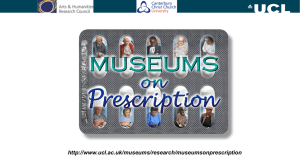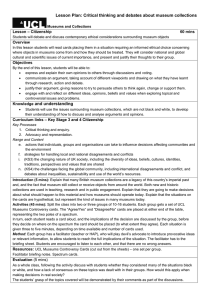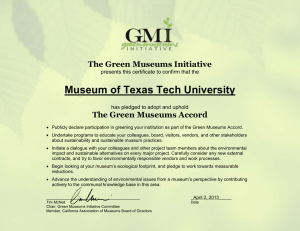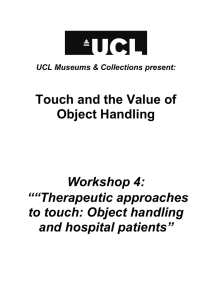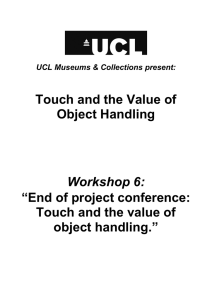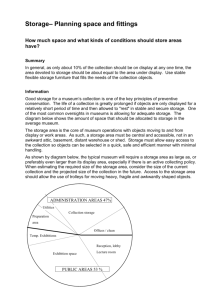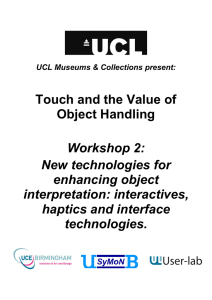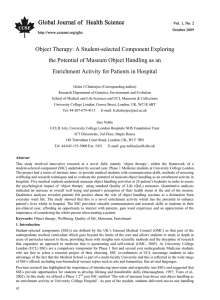Touch and the Value of Object Handling Workshop 1:
advertisement
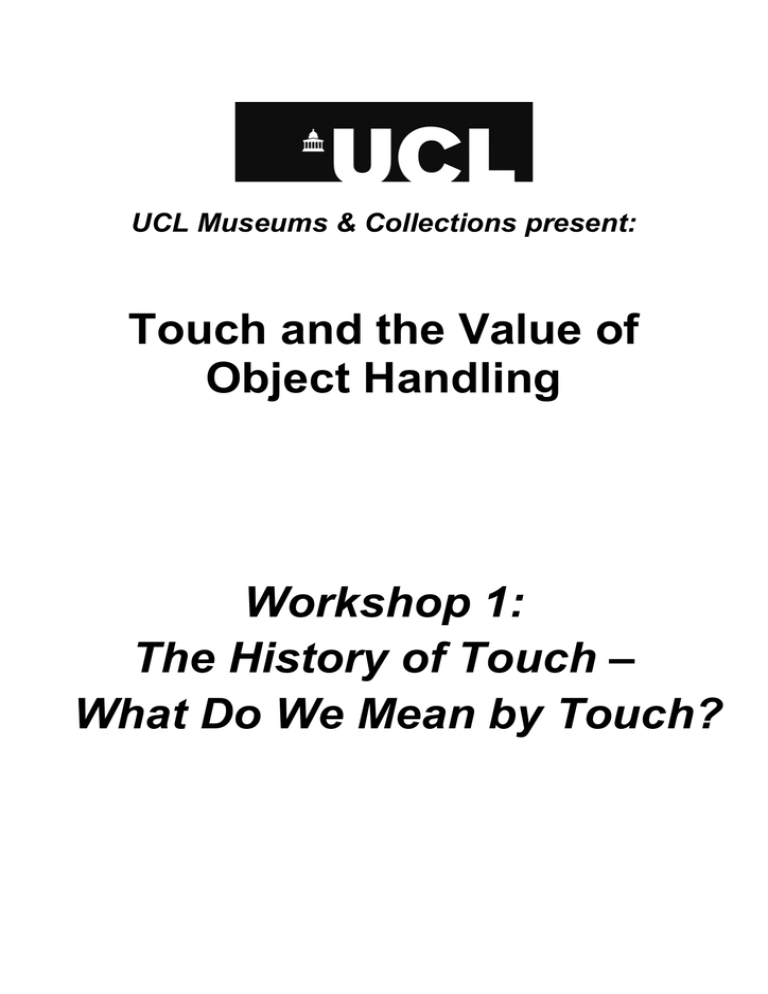
UCL Museums & Collections present: Touch and the Value of Object Handling Workshop 1: The History of Touch – What Do We Mean by Touch? Touch and the value of object handling An Arts and Humanities Research Council Research Networks Scheme organised by UCL Museums & Collections During the winter of 2006 and the spring of 2007 UCL Museums & Collections organised a series of workshops investigating touch and value of object handling in museums. Funded by the Arts and Humanities Research Council, the workshops brought together a diverse range of experts from academic and museum environments, with a view to establishing a network where information relating to the value of object handling can be shared and developed. Participants in the project came from a variety of backgrounds and brought with them a diverse range of expertise, research interests and museum access requirements. Scientists shared their knowledge of the underlying psychological and neurological mechanisms behind touch and sensation. Museum staff discussed the types of practical applications of touch employed in museum such as interactive displays, handling boxes and new technologies for interpreting objects. The union of these two groups afforded a unique opportunity to understand the true value of object handling and provide the museum world with a valuable toolkit for improving access and interpretation. For further information about this initiative please contact: Dr Helen Chatterjee, Deputy Director, UCL Museums & Collections Email: h.chatterjee@ucl.ac.uk Tel: 020 76794113 Workshop 1: Abstracts “The class politics of touch” Dr. Fiona Candlin The School of Continuing Education Birkbeck, University of London There is some considerable evidence that visitors to the first public museums touched the collections. David Howes and Constance Classen have suggested that this had stopped by the early to mid nineteenth century, a change that they attribute to modern notions of observation, objective science, surveillance techniques, the visual display of capitalism and the increasingly equation of touch with 'primitive cultures'. This is an excellent analysis but what it forgets is the degree to which class inflects touch. A closer analysis reveals that the upper classes always had licence to touch and their touch was deemed rational and non-damaging. On the few occasions when the lower classes could touch museum collections it was considered unruly and dirty. Moreover, in many cases their entrance to museums was actively restricted. It is only when museums become properly public and open to all classes rather than just an elite that touch was prohibited. The question remains, is a similar dynamic still in place today? Is an elite touch still considered rational? used rationally by Is the touch of the masses still filthy? “Weighty issues in handling objects” Professor Alan Wing Behavioural Brain Sciences Centre, School of Psychology, University of Birmingham Touch and vision both provide information about certain object attributes, such as shape and surface texture. However, appreciation of other object attributes, including weight and compliance, is limited to touch. In my talk I will review the neurophysiology of cutaneous (tactile) and proprioceptive (muscle) touch. I will then summarise touch functioning in the conscious perception of weight and interactions between judgments of weight and size. “Emotional touch: a neuroscientific overview” Dr. Hugo Critchley Wellcome Senior Research Fellow in Clinical Science Wellcome Department of Imaging Neuroscience Institute of Neurology, UCL Skin is a primary interface between an individual and environment. The sense of touch informs and guides proximal interaction with the outside. The skin is also the largest organ in the body and is central both to homoeostasis, ensuring the stability of the internal environment and to emotional and motivational signalling. Touch, as an exploratory sense, is complemented by parallel sensations intrinsic to the skin that have strong motivational salience. The unmyelinated nerves that convey these allied sensations (including sensual touch, tickle, temperature and pain) are of the same type as nerves that innervate and control the internal bodily organs. These visceral and dermal sensations reach the brain by a unique spinothalamic tract, separate from 'analytic' touch. Within the brain, the information by-passes somatosensory cortex access 'emotional' regions that support emotional feeling states, guide and motivate behaviour and reinforce memories. I will discuss evidence for this Emotional touch system “Discriminative and affective touch are subserved by separate peripheral and central neural systems” Professor Francis McGlone Cognitive Neuroscience – CSIG, Unilever Research and Development The skin senses have traditionally been divided into three sub-modalities: touch, temperature and pain, and there is a relatively robust understanding of the peripheral and central neural counterparts of this somatosensory system. It has been known for some time that in mammals there is a class of peripheral nerve fibres (c-fibres) that respond to light touch (stroking movements), but that in primates, and particularly humans, this system has been viewed as vestigial at best. In humans, c-fibres are classified as either subserving our sense of pain, or controlling autonomic function e.g. sweating, blood flow to the skin. This talk will describe a 'converging methodologies' approach that will outline recent research that exposes a 'pleasant touch' system in human skin employing psychophysical, neurobiological, behavioural and neuroimaging approaches. “Multisensory contributions to 'touch': Recent findings” Professor Charles Spence Head of the Crossmodal Research Laboratory, Department of Experimental Psychology, Oxford University The last few years has seen a growing realization amongst scientists that human perception is inherently multisensory. In particular, a rapidly growing body of research now highlights the existence of important connections between the human senses of sight, hearing, touch, smell, and taste. One consequence of the multisensory nature of our perceptual experience is that changing what a person sees can change what they feel when they touch/interact with an object/surface. Similarly, research now suggests that changing what an object or surface sounds like, even what it smells like, can also change how it will be perceived, evaluated, and ultimately used. In this talk, I hope to illustrate how our growing understanding of the rules governing multisensory perception (derived from the field of cognitive neuroscience research) demonstrates just how multisensory what we introspectively think of as tactile perception, or the sense of touch, really is. I also hope to highlight some of the challenges that one needs to face when trying to apply laboratorybased research findings to account for our real-world tactile interactions.

